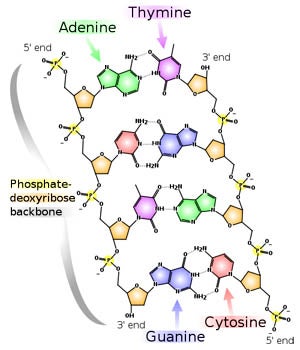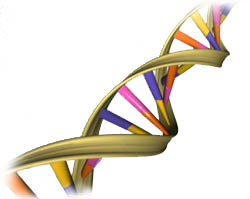DNA Structure

A closer look at the chemical structure of DNA shows four main building blocks. We call these nitrogenous bases: Adenine (A), Thymine (T), Guanine (G), and Cytosine (C). DNA also includes sugars and phosphate groups (made of phosphorus and oxygen). These make the phosphate-deoxyribose backbone.
If you think of the structure of DNA as a ladder, the rungs of the ladder (where you would put your hands) are made from the nitrogenous bases. These bases pair up to make each step of the ladder. They also only pair up in a specific way. (A) always pairs with (T) and (G) always pairs with (C). This is very important when it is time to copy all or part of the DNA.
DNA Shape

The most common DNA shape illustrated by artists and scientists looks a lot like a twisting ladder. Scientists call this a double helix. DNA also folds and coils itself into more complex shapes. The coiled shape makes it very small. In fact, it is small enough to easily fit inside any of our cells. This is a pretty amazing feat when you find out that the DNA from one cell, if unfolded, would stretch out to a length of six feet (almost two meters).

DNA does more than store information. It is also able to make copies of itself. To do this, it first has to unzip the nitrogenous bases. All the pairs of "AT" and "GC" are separated. The DNA then has two single strands. At this point new pairs are made, along with a new phosphate backbone, to create two new copies of DNA. Each single strand then pairs with a correct complementary base to create a new double-stranded piece of DNA. The copies will match because only "A" pairs with "T" and only "G" pairs with "C".
Additional images by NIH.
Read more about: DNA ABCs
Bibliographic details:
- Article: DNA Structure and Shape
- Author(s): Dr. Biology
- Publisher: Arizona State University School of Life Sciences Ask A Biologist
- Site name: ASU - Ask A Biologist
- Date published:
- Date accessed:
- Link: https://askabiologist.asu.edu/dna-shape-and-structure
APA Style
Dr. Biology. (). DNA Structure and Shape. ASU - Ask A Biologist. Retrieved from https://askabiologist.asu.edu/dna-shape-and-structure
Chicago Manual of Style
Dr. Biology. "DNA Structure and Shape". ASU - Ask A Biologist. . https://askabiologist.asu.edu/dna-shape-and-structure
Dr. Biology. "DNA Structure and Shape". ASU - Ask A Biologist. . ASU - Ask A Biologist, Web. https://askabiologist.asu.edu/dna-shape-and-structure
MLA 2017 Style

How can the environment affect DNA? Learn more at Ask An Anthropologist's story Controlling the Code.
Be Part of
Ask A Biologist
By volunteering, or simply sending us feedback on the site. Scientists, teachers, writers, illustrators, and translators are all important to the program. If you are interested in helping with the website we have a Volunteers page to get the process started.

